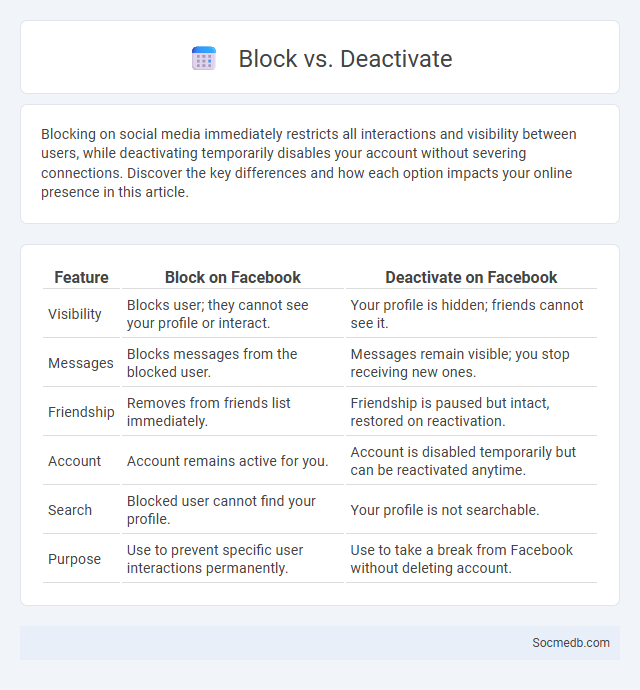
Photo illustration: Block vs Deactivate
Blocking on social media immediately restricts all interactions and visibility between users, while deactivating temporarily disables your account without severing connections. Discover the key differences and how each option impacts your online presence in this article.
Table of Comparison
| Feature | Block on Facebook | Deactivate on Facebook |
|---|---|---|
| Visibility | Blocks user; they cannot see your profile or interact. | Your profile is hidden; friends cannot see it. |
| Messages | Blocks messages from the blocked user. | Messages remain visible; you stop receiving new ones. |
| Friendship | Removes from friends list immediately. | Friendship is paused but intact, restored on reactivation. |
| Account | Account remains active for you. | Account is disabled temporarily but can be reactivated anytime. |
| Search | Blocked user cannot find your profile. | Your profile is not searchable. |
| Purpose | Use to prevent specific user interactions permanently. | Use to take a break from Facebook without deleting account. |
Understanding "Block" in Digital Platforms
On digital platforms, the "Block" feature is designed to prevent unwanted interaction or content visibility from specific users, ensuring personal safety and privacy. Various platforms like Facebook, Twitter, and Instagram implement blocking by restricting communication, profile access, and content sharing from the blocked individual. Understanding how the block function operates across different social media networks helps users maintain control over their online environment and minimize harassment or spam.
What Does "Deactivate" Mean?
Deactivating your social media account means temporarily disabling your profile, making it invisible to other users while retaining your data for future reactivation. Your posts, comments, and messages are hidden, but not deleted, ensuring you can return without losing content. This option is useful if you want a break from social media without permanently deleting your presence.
Ban" Explained: A Comprehensive Definition
A social media ban refers to the restriction or complete prohibition of access to specific social media platforms by governments, organizations, or service providers. These bans are often implemented due to concerns over misinformation, national security, cyberbullying, or content violating local laws and regulations. Enforcement methods include IP blocking, account suspensions, or app removal, impacting millions of users and digital communication globally.
Key Differences Between Block, Deactivate, and Ban
Blocking on social media restricts a specific user's interactions, preventing them from viewing your profile or contacting you while keeping your account active. Deactivating temporarily disables your account, hiding your profile and content from others, with the option to reactivate and restore data later. Banning, typically enforced by platform administrators, permanently removes a user from the social network for violating policies, eliminating access and content without the possibility of return.
When Should You Block Someone?
You should block someone on social media if their behavior harms your mental well-being, including harassment, threats, or consistent negative interactions. Blocking protects your personal space and ensures your online experience remains positive, letting you control who can engage with your content. Your digital safety and comfort are paramount, so taking this step when necessary maintains a healthy social environment.
Situations that Warrant Deactivation
Situations that warrant social media deactivation include experiencing online harassment, maintaining mental health, and protecting privacy after a data breach. If your social media usage causes stress, anxiety, or distraction from personal goals, deactivating your accounts can provide relief and restore focus. You should consider deactivation when privacy concerns outweigh the benefits of staying connected on these platforms.
The Impact of a Ban on Digital Accounts
A ban on digital accounts disrupts your social media presence by cutting off access to personal data, followers, and content history. This loss hampers communication, brand visibility, and engagement, severely impacting online reputation and business continuity. Recovery often requires rebuilding networks and digital assets from scratch, posing significant challenges for individuals and organizations alike.
User Experience: Blocked vs Deactivated vs Banned
Understanding the difference between blocked, deactivated, and banned social media accounts significantly impacts Your user experience and privacy control. Blocking prevents specific users from interacting with Your content without affecting account accessibility, while deactivating temporarily suspends Your profile, hiding it from public view without permanent deletion. Banning, typically enforced by the platform for policy violations, permanently restricts access, removing Your ability to engage or recover the account.
Security and Privacy Implications
Social media platforms often collect extensive user data, raising significant security and privacy concerns. Unauthorized access, data breaches, and misuse of personal information highlight the need for robust encryption, two-factor authentication, and strict privacy settings. Users must stay informed about platform policies and implement security best practices to protect their digital identities.
Choosing the Right Action: Block, Deactivate, or Ban
Choosing the right action on social media--blocking, deactivating, or banning--depends on the severity of the interaction and the desired level of privacy or control. Blocking prevents specific users from viewing or interacting with your profile, ideal for managing personal boundaries without fully removing content. Deactivating temporarily hides your entire profile and content without deletion, while banning permanently restricts users or removes harmful content from groups or pages to maintain community standards.
 socmedb.com
socmedb.com